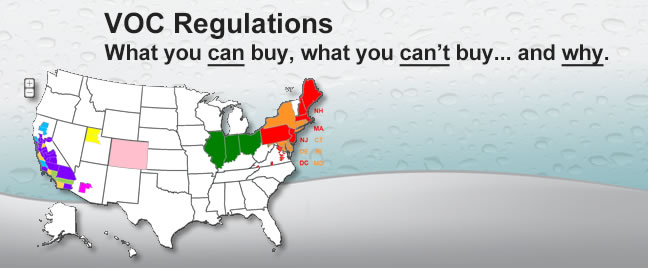Concrete is used in all types of outdoor construction. It is one of the most common materials used to build driveways, pool decks, patios, porches and sidewalks. Outdoors, you will find three basic types of concrete: Stamped Concrete, Broom Swept Concrete and Exposed Aggregate. All three types can be stained, dyed or colored in an almost endless palate of colors to fit any style or design.
There are many different choices when it comes to deciding which concrete or cement stain, dye or coloring system is right for your outdoor staining project. Desired color, your surroundings and even the concrete itself will all play a part in the decision you make. If your concrete has ever been stained or sealed in the past, you will also need to consider the new stain’s compatibility with your existing stain and / or sealer. We offer a full range of stain options for all types of driveway, patio, sidewalk and outdoor decorative concrete staining projects. Also keep in mind that most stains and dyes also require a protective sealer to protect the colored concrete from wear, spills and erosion. The sealer you choose will also influence the final color and appearance of your stained concrete project. Be sure to see our “Help Center” page specifically for sealing decorative concrete.
Below, we will take a look at the three types of concrete typically found outdoors. For each type of concrete, we will discuss basic cleaning and preparation techniques, along with the different types of stains available for each type of surface. In addition to the resources here in the “help center”, you can also find detailed information and color charts for every product we offer, by visiting that product’s page. We know how confusing all of this can be, but that’s what we’re here for! If you have questions, give us a call or send us an email and we’ll be glad to help you through the process.
Staining Stamped Concrete
This is concrete that has been stamped with a pattern to resemble natural stone or brick. Most stamped concrete is also colored or stained during or immediately after the stamping process. Almost all stains and sealers are suitable for new stamped concrete. For restoration of existing stamped concrete, you should always test for compatibility with your existing stain and sealer before application. Unless you choose a tinted “stain and sealer in one”, you will most likely need to completely remove the old existing sealer before re-staining or re-coloring.
Step 1:
Stamped Concrete Cleaning and Preparation
As with all projects, proper preparation is the MOST important step! Before any coloring system can be applied, any non-compatible existing stains and / or sealers MUST be removed and the surface completely cleaned and de-greased to ensure adhesion and penetration. If you are applying a tinted sealer to enhance and restore the color to your stamped concrete, a thorough pressure washing and if possible scrubbing with a mal-grit brush is typically all that is required before applying a compatible product. If you plan to use a separate stain or dye, you will need to strip all existing sealers and / or stains from the surface before re-staining.
- Recommended Products:
 F9 Double Eagle
F9 Double Eagle
Degreaser Nock-Off
Nock-Off
Coating Stripper Surf-Prep
Surf-Prep
Etching Cleaner Malish
Malish
Scrubbing Brushes
Staining Option 1:
Concrete Acid Stains
Also called reactive stains, these traditional stains create a chemical reaction with the minerals in concrete. Acid staining is the most common and recommended method of coloring outdoor concrete. Available in a variety of earth tones, these UV stable stains are permanent and require a sealer topcoat. All types of sealers can be used over acid stains, including penetrating sealers for protection without the worry of the surface becoming slippery when wet.
- Recommended Products:
 SurfKoat
SurfKoat
Concrete Acid Stain Balance
Balance
Concrete Neutralizer Swissmex
Swissmex
Acid Sprayer
Staining Option 2:
Concrete Acetone Dyes
Concrete Dyes are the latest technology in concrete coloring. They are much easier to apply, available in many more colors than the acids and give more predictable results. Dyes typically come in a concentrate form that you dilute with acetone before use. Dyes require no sloppy neutralizing or rinsing, and can be sealed almost immediately after application. UV stability will vary depending on the specific formulation. Our Liquid Dyes are fully UV stable and require a film-forming top-coat to protect the color and lock them in place.
- Recommended Products:
 Surfkoat
Surfkoat
Kolour Dye Swissmex
Swissmex
Acetone Sprayer
Staining Broom Concrete
This is plain old regular everyday concrete. It is usually gray in color with a rough texture. This is the concrete commonly found on driveways, sidewalks and parking lots. Almost all stains and sealers are suitable for new broomed concrete. For restoration of existing stained and / or sealed concrete, you should always test for compatibility with your existing stain and sealer before application. Unless you choose a tinted “stain and sealer in one”, you will most likely need completely remove the old existing sealer before re-staining or re-coloring.
Step 1:
Broom Concrete Cleaning and Preparation
As with all projects, proper preparation is the MOST important step! Before any coloring system can be applied, any non-compatible existing stains and / or sealers MUST be removed and the surface completely cleaned and de-greased to ensure adhesion and penetration. In most cases, a thorough pressure washing is all that is needed before staining clean, bare, un-sealed broom-swept concrete that is still in good condition. If you are applying a tinted sealer to enhance and restore the color to your existing decorative concrete, a thorough pressure washing and if possible scrubbing with a mal-grit brush is typically all that is required before applying a compatible product. If you plan to use a separate stain or dye, you will need to strip all existing sealers and / or stains from the surface before re-staining.
- Recommended Products:
 F9 Double Eagle
F9 Double Eagle
Degreaser Nock-Off
Nock-Off
Coating Stripper Surf-Prep
Surf-Prep
Etching Cleaner Malish
Malish
Scrubbing Brushes
Staining Option 1:
Concrete Acid Stains
Also called reactive stains, these traditional stains create a chemical reaction with the minerals in concrete. Acid staining is the most common and recommended method of coloring outdoor concrete. Available in a variety of earth tones, these UV stable stains are permanent and require a sealer topcoat. All types of sealers can be used over acid stains, including penetrating sealers for protection without the worry of the surface becoming slippery when wet.
- Recommended Products:
 SurfKoat
SurfKoat
Concrete Acid Stain Balance
Balance
Concrete Neutralizer Swissmex
Swissmex
Acid Sprayer
Staining Option 2:
Concrete Acetone Dyes
Concrete Dyes are the latest technology in concrete coloring. They are much easier to apply, available in many more colors than the acids and give more predictable results. Dyes typically come in a concentrate form that you dilute with acetone before use. Dyes require no sloppy neutralizing or rinsing, and can be sealed almost immediately after application. UV stability will vary depending on the specific formulation. Our Liquid Dyes are fully UV stable and require a film-forming top-coat to protect the color and lock them in place.
- Recommended Products:
 Surfkoat
Surfkoat
Kolour Dye Swissmex
Swissmex
Acetone Sprayer
Staining Option 3:
Tinted Acrylic “Sealer Stains”
Tinted acrylic sealer is an easy to apply, one step product that protects concrete from water and salt damage while also applying a rich transparent or solid color. With this system, color is simply added to your choice of solvent-based acrylic sealer to create the exact color you desire. This is an extremely easy and effective way to add color to concrete without the mess and additional labor of staining. Two coats are usually recommended for uniform appearance. To maintain protection and appearance, this product should have a maintenance coat every 3-4 years.
We offer two different options for adding color to your clear sealer.
For a solid color or more opaque coating, use our AcrylPack Color System. The AcrylPack System makes it easy to create a UV stable, pure acrylic stain and sealer in one. AcrylPack Color is available in 14 standard colors. Colors can also be mixed to create endless combinations. Simply add less pigment to achieve a semi-transparent color or use more for a solid opaque color. This system is very popular for driveways, sidewalks, pool decks, patios and all types of outdoor concrete. It’s high solids formula is perfect for covering stains, discoloration or correcting mis-matched concrete colors.
For a more transparent coating, use our Liquid Kolour Dye Concentrate. This is the same liquid dye concentrate that we discussed in option 2, but this time we're using it to tint our clear sealer. Kolour Dye is available in 29 great colors. Colors can also be mixed to create endless combinations. Simply add less dye concentrate to achieve a more transparent color or use more for a more opaque color. This is an easy way to add a subtle color change to your outdoor project.
- Recommended Products:
 Stamp-Seal
Stamp-Seal
25% Pure Acrylic 2000 Supreme
2000 Supreme
25% Pure Acrylic AcrylPack
AcrylPack
Color System Surfkoat
Surfkoat
Kolour Dye
Staining Aggregate Concrete
This is probably the least common type of concrete for staining or coloring, but there are certain situations where it may be needed or desired. The most common reason for staining aggregate is make a new piece of concrete better match the color of an older existing slab. Since the exposed stones will accept the stain much differently than the concrete they are embedded in, always perform a test area to ensure desired results. For subtle color enhancement, you may also consider a tinted sealer such as our pre-tinted Aggreseal Supreme or other custom tinted acrylic. Our Aggreseal tint packs and Liquid Kolour Dye make it easy to tint clear Aggreseal or any of our other clear solvent-based acrylics.
Step 1:
Aggregate Concrete Cleaning and Preparation
As with all projects, proper preparation is the MOST important step! With the exception of some tinted sealers, all stains and dyes require that the concrete surface be clean, bare and un-sealed. If your aggregate concrete has an existing sealer, you will need to remove the old sealer before applying any stain or dye. In most cases, a thorough pressure washing is all that is needed for bare, un-sealed aggregate concrete.
- Recommended Products:
 F9 Double Eagle
F9 Double Eagle
Degreaser Nock-Off
Nock-Off
Coating Stripper Surf-Prep
Surf-Prep
Etching Cleaner Malish
Malish
Scrubbing Brushes
Staining Option 1:
Concrete Acid Stains
Also called reactive stains, these traditional stains create a chemical reaction with the minerals in concrete. Acid staining is the most common and recommended method of coloring outdoor concrete. Available in a variety of earth tones, these UV stable stains are permanent and require a sealer topcoat. All types of sealers can be used over acid stains, including penetrating sealers for protection without the worry of the surface becoming slippery when wet.
- Recommended Products:
 SurfKoat
SurfKoat
Concrete Acid Stain Balance
Balance
Concrete Neutralizer Swissmex
Swissmex
Acid Sprayer
Staining Option 2:
Tinted Acrylic Sealers
Tinted acrylic sealer is an easy to apply, one step product that protects concrete from water and salt damage while also applying a subtle transparent color. This is an extremely easy and effective way to add color to concrete without the mess and additional labor of staining.
Aggreseal is available pre-tinted brown, but if you would like to create your own custom tinted sealer in any color, our Kolour Dye can be added to clear Aggreseal or any of our other clear solvent-based acrylics to create a unique tinted sealer.
To maintain protection and appearance, this product should have a maintenance coat every 3-4 years.
- Recommended Products:
 Aggreseal
Aggreseal
30% Acrylic Surfkoat
Surfkoat
Kolour Dye















